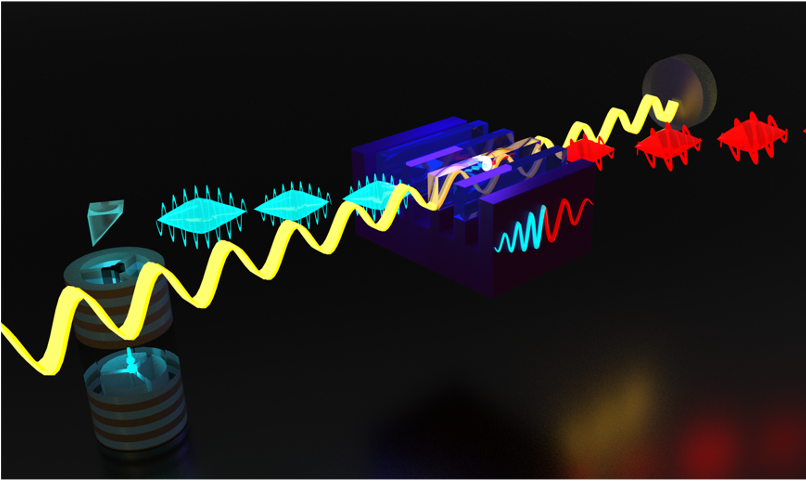
Bridging the gap — quantum frequency conversion of a quantum dot to telecom frequency
- Post by: admin
- June 10, 2021
- No Comment
We’ve had a new paper published together with Brian Gerardot’s group in Applied Physics Letters, highlighted by the editors and on the cover, no less. Chris from my group and Zak have kindly done a writeup for our physics undergrad society newsletter — see below.
Quantum information processing requires deterministic, high purity single-photon sources. However, for these sources to be compatible with existing telecommunication infrastructure they need to emit photons at 1550 nm, where attenuation in optical fibre is lowest. Currently the best deterministic single-photon sources are semiconductor quantum dots embedded in a microcavity [1]. Their major drawback lies in the fact that the emission wavelength of these sources is around 900 nm. It is possible to get around this drawback by converting the frequency of photons from these sources to telecommunication wavelengths. The heart of the mechanism lies in the interaction between the single photons and a strong pump beam in a waveguide fabricated out of a nonlinear crystal. This interaction annihilated a photon at the original frequency and produces a photon a new frequency given by the simple relation, 𝜔𝑜𝑢𝑡 = 𝜔𝑖𝑛 − 𝜔𝑝𝑢𝑚𝑝. This mechanism can be in principle noiseless, has been proven a
success in the past in converting non-classical light from a variety of different sources [2-5] telecommunication wavelengths. This allows one to utilize the vast catalogue of telecom components in addition to the access to the existing ultra-low-loss fibre infrastructure.

In our recent paper published in APL [6], we demonstrate near noiseless frequency conversion from near IR to telecom C-band via difference frequency generation. We report on bright, pure and indistinguishable single photons, generated from a InGaAs quantum dots embedded in a micropillar cavity. With this source,
this enables immediate application in quantum networking protocols, with ongoing works on exploring the feasibility of this source for secure quantum communication.
References
[1] Tomm, N. et. al., Nat. Nanotechnol. 16, 399–403 (2021).
[2] Bock, M. et. al., Nat. Commun. 9, 1998 (2018).
[3] Dréau, A. et. al., Phys. Rev. Applied 9, 064031 (2018).
[4] Weber, J.H. et. al., Nat. Nano. 14, 23–26 (2019).
[5] Albrecht, B. et. al., Nat Commun 5, 3376 (2014).
[6] Morrison, C.L. et. al., Appl. Phys. Lett. 118, 174003 (2021).
For more information you can read the full article here:
https://doi.org/10.1063/5.0045413